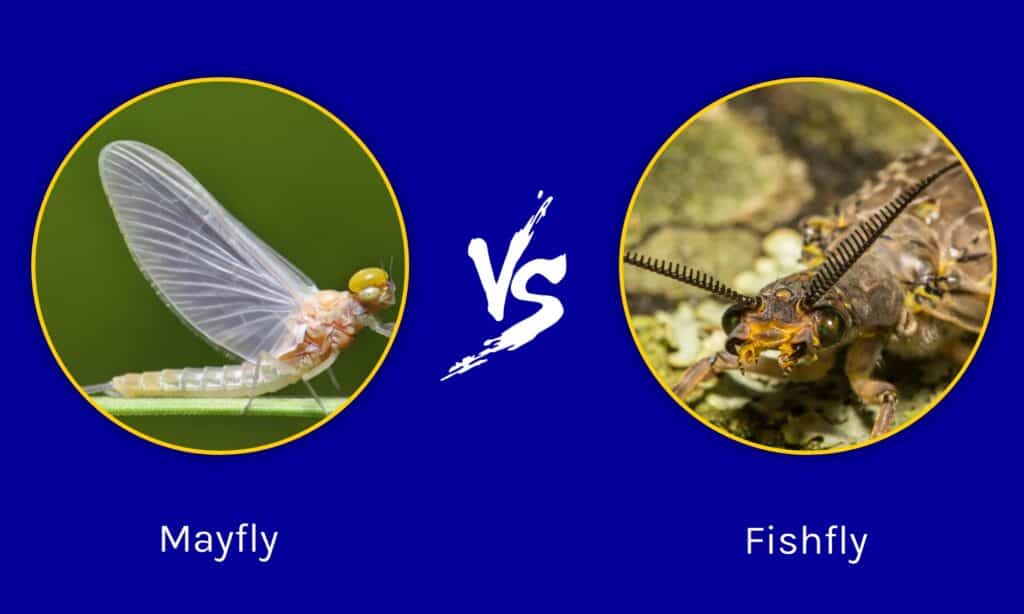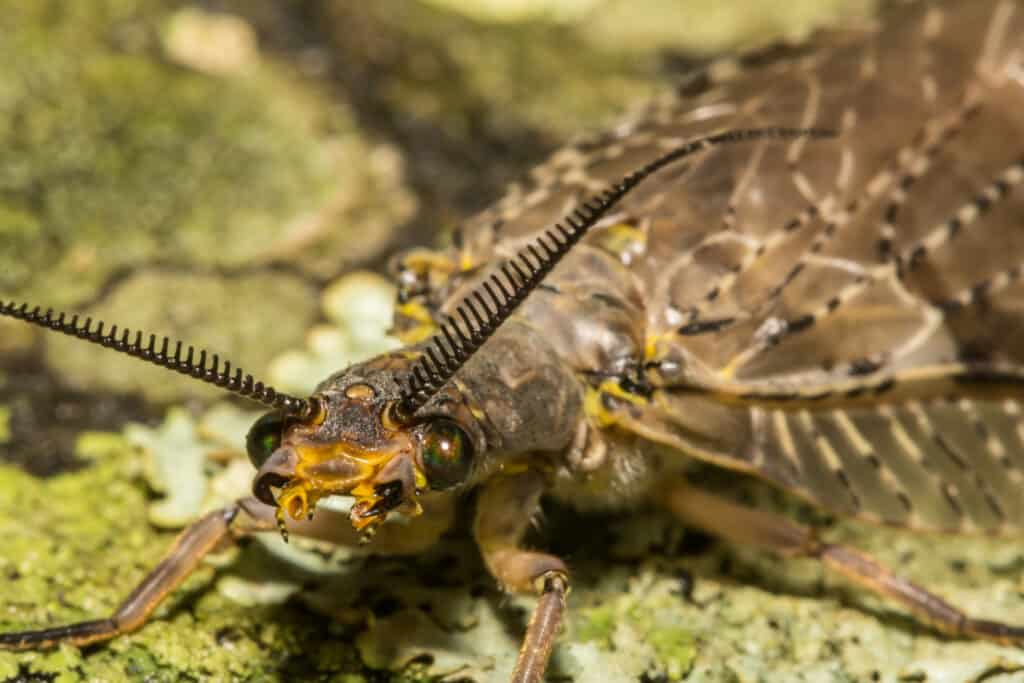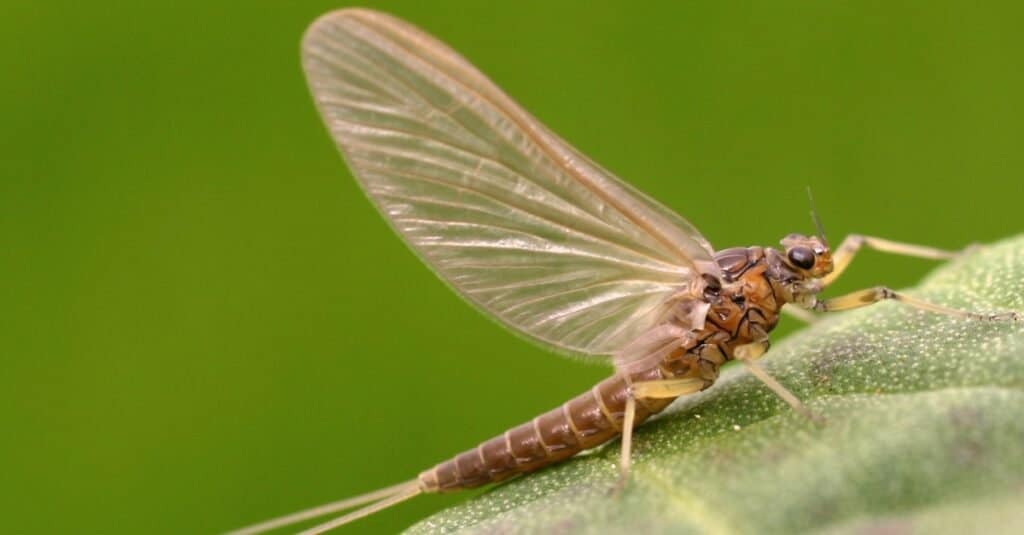Mayflies and fishflies are living fossils.
The 2 insects have been around for over 150 million years. Fishflies came into existence around the middle of the Jurassic period. While newly discovered fossils show that mayflies date back 312 million years!
At a glance, you could easily mistake a mayfly for a fishfly. But these bugs are incredibly different and lead unique lifestyles. Keep reading to learn the main differences between a fishfly vs mayfly.
Comparing Fishfly vs Mayfly

| Fishfly | Mayfly | |
|---|---|---|
| Names | Chauliodes rastricornis | Ephemeroptera |
| Range | Worldwide | Worldwide |
| Lifecycle | Egg, nymph, subimago, imago | Egg, nymph, subimago, imago |
| Appearance | Rusty gray color Long antenna Wings can be 3 inches long | Gray color Short antenna Wings are between 8 mm and 10 mm long |
| Human connection | Can’t bite humans Will pinch you Help control algae growth | Won’t bite or pinch humans Swarm seasonally Helpful to environment |
Key Differences Between Fishfly vs Mayfly
The key differences between a fishfly vs mayfly include their scientific names, range, habitat and lifecycle, appearance, and human impact.
Now, it’s important to note that when people use “mayfly” and “fishfly” they’re referring to the same type of insect! That’s because what’s commonly called a mayfly in the rest of the United States is often called a fishfly in the midwest and areas like Michigan that surround the Great Lakes.
So, what are we examining in this article? For the sake of this article, fishflies will refer to the family Corydalidae. These flies are often called different names such as dobson flies, but their correct name is fishflies.
Fishfly has a name that means rake-horned, while mayflies’ names mean short-lived. The names are fitting. Mayflies have shorter lifespans, and fishflies have impressive “horn-like” antennas.
As far as range, fishflies tend to stay towards North America, while mayflies have a wider distribution. Finally, both creatures play important roles in helping terrestrial and aquatic ecosystems. Keep reading to dive deeper into the differences between a fishfly vs mayfly.
Fishfly vs Mayfly: Scientific Name

The scientific name for mayfly is Ephemeroptera
©Dimijana/Shutterstock.com
The scientific name for a fishfly is Chauliodes rastricornis, but they may include many species across the family Corydalidae. Chauliodes translates to mean ‘remarkable tooth.’ Whereas ‘rasticornis’ translates to mean ‘rake-horned.’
The scientific name for mayfly is Ephemeroptera, which is an order that includes more than 3,000 species. It’s a Greek word that translates to mean ‘short-lived.’ Their name has to do with their incredibly short lifespans. Nicknames for the insect include drake, fishfly, sandfly, dayfly, and finally shadfly.
Fishfly vs Mayfly: Range and Distribution

Fishflies usually measure more than an inch long.
©iStock.com/JasonOndreicka
Where can you find fishflies? They mainly live in North America. For instance, summer flies are a common appearance in North America.
However, New World fishflies have a much wider spread. Three genera are endemic to the afro tropical realm. That means you’ll be able to find fishflies throughout South Africa and Madagascar. They live in Australia too!
Mayflies have a much broader range and distribution. You can find mayflies in South America, North America, Eurasia, Asia, and Africa. There are also mayflies in Central America and Oceania.
Oceania is a fantastic region with thousands of islands throughout the Central and South Pacific Oceans. Australia is one of the smallest continents you’ll find in Oceania. That means in Australia; you’ll be able to find mayflies and fishflies.
Fishfly vs Mayfly: Habitat and Life cycle

Fishflies and mayflies prefer aquatic habitats.
©iStock.com/rabbit75_ist
Like water frogs, you’ll find fishflies hanging out in aquatic regions. There are about 18 species of the fishfly family, and they spend most of their time near bodies of water. Streams, rivers, and ponds all make great homes for fishflies. They prefer the water because, during their juvenile stage, the larvae require an aquatic habitat.
When you find one fishfly, there will be other nearby. These bugs love living in large groups with their species. They lay their eggs near bodies of water in huge numbers. The fishfly larvae crawl into the water as soon as they hatch and spend most of their time underwater.
As an adult, a fishfly can live up to 7 days. However, the majority of their life is spent in the larva stage. As a juvenile, a fishfly can live for years underwater.
Similar to fishflies, mayflies spend the majority of their lives underwater. However, they have a much shorter lifespan. A mayfly will spend several months to a year max living underwater. The juveniles are called mayfly naiads, and when the time is right, they float to the top of the water and molt into the sub-adult state.
In the sub-adult state, the mayfly still can’t fly. It also can’t reproduce. However, in a matter of hours, it’ll get a chance to molt again and enter into the adult winged state.
New adults don’t have the ability to eat or drink; their sole purpose is to reproduce. Adult mayflies usually only live for a few hours, making them interesting to compare to craneflies too.
Fishfly vs Mayfly: Appearance

Mayflies have big buggy-looking eyes.
©iStock.com/englishriver
Fishflies usually have a rusty or gray color. Their wings will be white or clear. When looking at a fishfly, you’ll notice that they have two pairs of wings extending towards their body’s lower half. Their wings can reach a length of 3 inches, which is 7.6 cm. Their antennas are one of their most distinguishable characteristics. They have long feathery antennas.
Alternatively, mayflies have short antennas. Mayflies have slender body that makes them seem more defined. Their thin stature causes mayflies to look as if their eyes are much bigger than they are, giving them true bug eyes.
You’ll notice that mayflies have large, clear, triangular wings. A mayfly has much larger wings at the front of its body and tiny round wings behind them. The hind wings can be difficult to see, so you’ll have to look closely.
Throughout the wings, you’ll be able to notice horizontal and vertical veins that create a net-like pattern. You could compare a mayfly’s wings to a butterflies wings in how they are attached to the thorax.
Fishfly vs Mayfly: Human Connections

Mayflies and fishflies help serve terrestrial and freshwater ecosystems.
©Rashevskyi Viacheslav/Shutterstock.com
You don’t have to worry if you see a fishfly in the wild. While they can pinch you, they’re considered harmless bugs. Their pinch doesn’t cause any long-term problems, and they’re not aggressive bugs like mosquitoes. They don’t sting, and they don’t have mouths to bite you with.
As far as the ecosystem is concerned, fishflies are good news for the environment. Stream ecologists know that healthy fishfly populations usually mean good water quality.
Mayflies also don’t attack people, so you don’t have to worry about stings or bites. However, they are known for swarming. Mayflies emerge from lakes and rivers every summer and take to the skies. Scientists are still trying to pinpoint when their insect emergence starts.
Degree days might provide some helpful clues. During warm summer months, you can find mayflies swarming the Mississippi River Basin and Great Lakes. Sometimes the swarm is thick enough to appear on weather radar that tracks rain and snow!
Mayflies help serve humanity as vital parts of terrestrial and freshwater ecosystems. Other insects that play a significant role in the environment include ladybugs, dragonflies, and bees.
The photo featured at the top of this post is ©
Thank you for reading! Have some feedback for us? Contact the AZ Animals editorial team.






